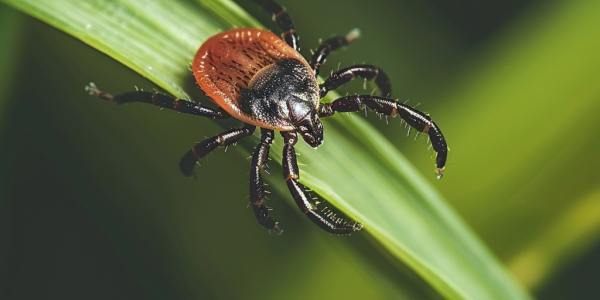Experts Warn of Early Arrival of Ticks in Ottawa and Associated Health Risks
Experts warn of early tick arrival in Ottawa due to warmer weather, increasing health risks. Deer ticks can transmit Lyme disease, babesiosis, anaplasmosis, and Powassan disease. Precautions such as staying on trails, wearing protective clothing, using repellent, and checking for ticks can help prevent illnesses.
Powassan Virus Detected in Massachusetts Town, Prompts Tick Precautions
The Powassan virus, a rare tick-borne disease, has been reported in Massachusetts, with two cases under investigation in 2024. This serious illness can lead to meningitis or encephalitis, with symptoms including fever, headache, and seizures. Dr. Goudarz Molaei warns of a significant mortality rate among Powassan patients, emphasizing the importance of tick bite prevention.
Uptick in Ticks: Milder Weather Extends Tick Seasons
Learn about the uptick in tick activity due to milder weather, leading to longer tick seasons. With cases of Lyme disease and anaplasmosis already recorded, pet owners are advised to be vigilant and remove ticks from their animals to prevent the spread of diseases.
Protecting Your Pets: Veterinarian Discusses Safeguarding Against Tick Bites
Learn from veterinarian Dr. Navjot Gosal about the importance of safeguarding against tick bites for both pets and humans. With tick season underway, it’s crucial for pet owners to be proactive in protecting their furry friends from potential tick-borne diseases. Stay informed and take preventive measures to minimize the risk of tick bites for your beloved companions.
Tick season arrives early in Canada as temperatures warm up
As temperatures rise in Canada, so do the ticks, with the unseasonably warm winter likely causing them to emerge weeks ago. Lyme disease, primarily spread by deer ticks, is on the rise in Canada due to climate change, with significant increase in reported cases. Experts warn of the heightened risk of tick-borne illnesses as ticks become active and start seeking hosts for blood meals. Canadians are urged to take necessary precautions to protect themselves and their pets from potential tick bites and illnesses.
Surge in Lyme Disease Cases Linked to Changes in Tracking Rules
The number of confirmed cases of Lyme disease in the United States has surged after recent changes in tracking rules. Reported cases rose by 68.5% in 2022 following updated definitions, shedding light on the true prevalence of the tick-borne disease. Health authorities are now better equipped to identify and report cases accurately, providing a clearer picture of the disease’s impact.
CDC Reports Significant Rise in Lyme Disease Cases Due to Changes in Surveillance Methods
The CDC has reported a 69% increase in Lyme disease cases in the US, but this surge is due to changes in surveillance methods. The new approach requires only a positive blood test result for reporting cases in high-incidence states, uncovering 62,551 cases in 2022. This shift aims to provide a more accurate picture of the disease’s burden and simplify the reporting process. Lyme disease is most prevalent in the Northeast, Midwest, and mid-Atlantic states, and is caused by the bacterium Borrelia burgdorferi, transmitted through blacklegged tick bites. The rise in cases may also be attributed to better, more sensitive testing. Despite the changes, the fight against Lyme disease continues as public health officials and researchers work towards better understanding and managing the impact of this prevalent disease.
U.S. Department of Health and Human Services Releases National Public Health Strategy to Prevent and Control Vector-Borne Diseases
The U.S. Department of Health and Human Services has released the National Public Health Strategy to Prevent and Control Vector-Borne Diseases in People (VBD National Strategy), marking a significant step in combating the growing threat of diseases spread by vectors such as mosquitoes, ticks, fleas, and lice. The strategy, developed by 17 federal departments and agencies, is a result of a four-year process initiated by the 2019 Kay Hagan Tick Act. This interagency plan aims to address the challenges related to vector-borne diseases and outlines federal priorities to detect, prevent, respond to, and control these diseases and conditions in the United States.
The Significance of Skin as an Indicator of Overall Health
The skin, our largest organ, provides valuable insights into our overall well-being. Conditions like Lyme disease and purpura can manifest as rashes, offering early detection of underlying health issues. Paying attention to changes in the skin can help individuals safeguard their health and well-being.
The Global Health Impact of Major Disease Outbreaks in 2023
As the year 2023 came to a close, it was marked by the resurgence of numerous diseases, leaving an indelible imprint on global public health. The ten major outbreaks that unsettled the world included the persistent COVID-19, the emergence of…










